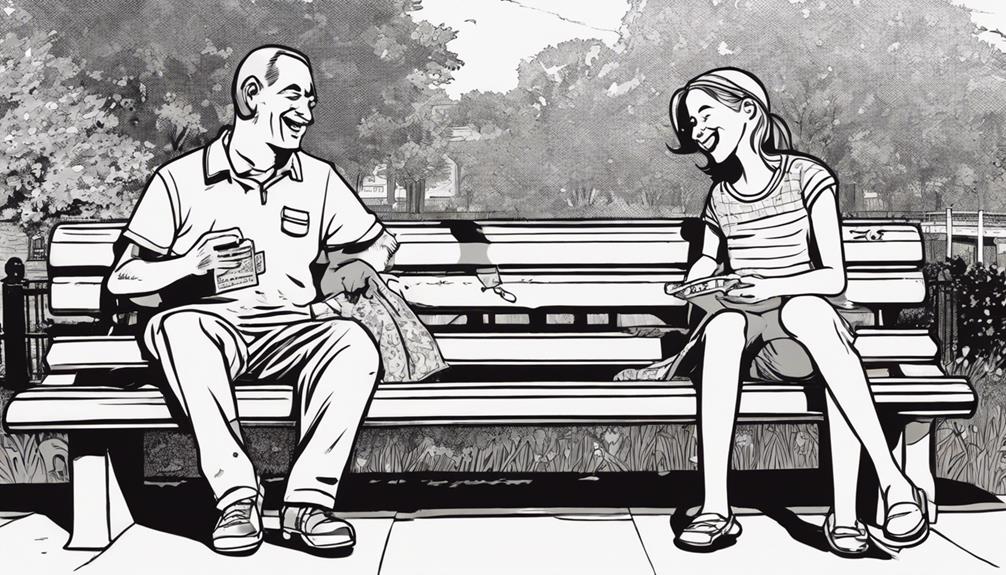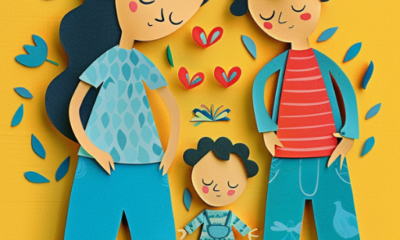General Tips
Heartfelt and Humorous Father-Daughter Quotes Galore
A delightful collection of touching and funny quotes celebrating the unique bond between fathers and daughters, guaranteed to warm your heart.

Get ready for a mix of heartfelt and funny father-daughter quotes that showcase the beautiful bond between dads and daughters. These quotes capture moments of love, support, and admiration, while also adding humor and wit to the relationship. Daughter's quotes express gratitude, love, and respect, highlighting the special connection with fathers. Song lyrics about fatherhood provide solace and inspiration, emphasizing fathers as pillars of strength. Cute quotes bring warmth and illustrate the overwhelming love in fatherhood. Each quote evokes emotions and memories that resonate deeply with all who cherish the father-daughter relationship.
Key Takeaways
- Heartfelt quotes capture emotional father-daughter bond.
- Funny quotes bring humor to special moments.
- Daughter's quotes express gratitude and admiration.
- Song lyrics convey the eternal love between fathers and daughters.
- Cute quotes highlight the irreplaceable bond shared between fathers and daughters.
Heartfelt Father-Daughter Quotes
Heartfelt Father-Daughter Quotes showcase the deep emotional bond and love between fathers and daughters. These quotes reflect the profound connection that exists between a father and his daughter.
They capture moments of love, support, and admiration that define this special relationship. From Elaine S. Dalton's powerful words about a father's love for his daughter's mother to Kevin Hart's emotional experience at a father-daughter dance, these quotes convey the unique bond shared between fathers and daughters.
Taylor Swift's reflection on her father's unwavering belief in her and Bindi Irwin's heartfelt tribute to her dad as her hero further highlight the significance of this relationship. These quotes resonate with many, underscoring the irreplaceable role fathers play in their daughters' lives.
Funny Father-Daughter Quotes

Let's shift gears and explore the lighter side of the father-daughter relationship with some amusing and witty quotes in the domain of 'Funny Father-Daughter Quotes'.
John Sinor humorously remarked, 'It is admirable for a man to take his son fishing, but there's a special place in heaven for the father who takes his daughter shopping.'
Stanley T. Banks added a touch of comedy with, 'You fathers will understand. You have a little girl. She looks up to you. You're her oracle. You're her hero.'
Ben Sirach quipped, 'A daughter is a treasure and a cause of sleeplessness.'
Unknown cleverly stated, 'One of life's greatest mysteries is how the boy who wasn't good enough to marry your daughter can be the father of the smartest grandchild in the world.'
To conclude, Bryan Pulsifer amusingly noted, 'A daughter can lead to baldness, but the remainder of the road is just as smooth.'
Daughter's Quotes to Dad

When looking for ways to express gratitude or admiration towards their fathers, daughters often turn to heartfelt and inspiring quotes. These quotes serve as a way for daughters to convey their love, appreciation, and respect for their dads.
Daughters may choose quotes that reflect the special bond they share with their fathers, highlighting the role their dads play in their lives. Whether it's a simple 'I love you, Dad' or a more elaborate quote expressing deep emotions, these words can hold significant meaning for both the daughter and her father.
Song Lyrics About Fatherhood

Daughters often find solace and inspiration in song lyrics that encapsulate the essence of fatherhood, reflecting the profound impact their dads have on their lives. John Mayer's 'Daughters' reminds us of the importance of fathers in shaping their daughters' worlds, emphasizing their role as pillars of strength.
Michael Bublé's 'Daddy's Little Girl' beautifully portrays the special bond between a father and his daughter, likening her to a treasure at the end of the rainbow.
Paul Simon's 'Father and Daughter' eloquently expresses a father's eternal love for his child, emphasizing the unbreakable connection between them.
Jason Blaine's 'Dance With My Daughter' captures the fleeting yet cherished moments shared between a father and his little girl, highlighting the joy found in simple acts of love.
Cute Quotes About Father-Daughter Bond

Exploring the sweetness of the father-daughter bond through endearing quotes brings warmth to the heart and a smile to the face.
One quote that captures this sentiment is, 'The only way I could describe [fatherhood]… at the end of How the Grinch Stole Christmas, you know how his heart grows, like, five times its size? Everything is full. It's just full all the time,' shared by Matt Damon.
This quote beautifully illustrates the overwhelming love and fulfillment that fathers experience in their relationship with their daughters. It highlights the profound impact daughters have on their fathers, filling their lives with joy and contentment.
Such quotes remind us of the special and irreplaceable bond shared between fathers and daughters.
Relationships Dynamics in Quotes

Let's explore the various dynamics of relationships portrayed through meaningful quotes between fathers and daughters.
| Relationship Dynamic | Description | Example Quote |
|---|---|---|
| Loving and Supportive | Fathers who show unwavering love and support towards their daughters. | 'My dad believed in me, even when I didn't.' – Taylor Swift |
| Playful and Fun | Dads who share a light-hearted and jovial bond with their daughters. | 'It is admirable for a man to take his son fishing, but there is a special place in heaven for the father who takes his daughter shopping.' – John Sinor |
| Complex and Strained | Relationships with ups and downs, where emotions might be more intricate. | 'When my daughter says, 'Daddy, I need you!' I wonder if she has any idea that I need her a billion times more.' – Stanley Behrman |
| Reflective and Nostalgic | Quotes that evoke memories, reflection, or sentimentality about the father-daughter relationship. | 'So you'll always know, as long as one and one is two, there could never be a father who loved his daughter more than I love you.' – Paul Simon |
Additional Resources for Dad-Daughter Relationships

I frequently recommend exploring a variety of resources to enhance the bond between fathers and daughters. These resources can include books on fatherhood and parenting, online articles and blogs dedicated to dad-daughter relationships, parenting workshops, or seminars, and even father-daughter activities or retreats.
Websites like Dadilife offer valuable insights into modern fatherhood, providing tips and advice on building strong connections with daughters. Additionally, following experts like Jonathan Davies can offer a wealth of knowledge and support in navigating the complexities of father-daughter dynamics.
Frequently Asked Questions
How Can Father-Daughter Quotes Help Strengthen the Bond Between Them?
Father-daughter quotes help strengthen our bond by expressing love, admiration, and humor. They remind us of shared moments and emotions, fostering understanding and connection. These quotes serve as heartfelt reminders of our special relationship.
Are There Any Quotes That Address the Challenges Fathers and Daughters Face?
Facing challenges together can strengthen the father-daughter bond. One study found that open communication and mutual respect can improve relationships. By addressing difficulties with honesty and empathy, fathers and daughters can navigate tough times successfully.
Can Quotes About Father-Daughter Relationships Be Used for Special Occasions?
Quotes about father-daughter relationships are versatile and fitting for special occasions. Personal favorites can add a heartfelt touch to celebrations, reminding us of cherished moments and strengthening bonds through shared sentiments and memories.
Do Father-Daughter Quotes Vary Based on the Daughter's Age?
Father-daughter quotes do vary based on the daughter's age. They evolve from guiding and protective sentiments for young daughters to reflections on independence and pride for grown daughters. The quotes adapt to capture the changing dynamics and experiences over time.
Are There Any Quotes That Focus on the Unique Memories Shared Between Fathers and Daughters?
Yes, there are quotes that beautifully capture the unique memories shared between fathers and daughters. These quotes often reflect moments of joy, love, and connection that create lasting bonds and cherished memories for both.
Conclusion
To sum up, these heartfelt and humorous father-daughter quotes offer a glimpse into the special bond shared between dads and their daughters.
From sentimental expressions of love to lighthearted quips that capture the unique dynamics of this relationship, these quotes celebrate the joy and support fathers bring into their daughters' lives.
So, whether you're looking for a touching sentiment to share with your dad or a funny anecdote to brighten his day, these quotes are sure to touch the heart and tickle the funny bone.
General Tips
How to Help a Baby Discover Hands: Developmental Activities
Wander through engaging sensory activities to promote your baby's hand discovery and development, unlocking a world of exploration and growth.

To support your baby in discovering their hands and promoting development, engage in sensory stimulation activities such as Peek-a-boo and colorful mobile play. These activities can improve social skills, cognitive abilities, and hand-eye coordination. Introduce textured toys and tactile experiences to encourage sensory exploration. Use contrasting colors, patterns, and interactive play to stimulate vision development and motor skills. Follow safety guidelines to create a secure play environment. Encourage reaching and grasping milestones through intentional toy design and strategic placement. Talking daily can help with language development. By incorporating these activities, you can further support your baby’s progress and exploration.
Key Takeaways
- Encourage grasping by offering textured toys.
- Engage in sensory play with various textures.
- Use colorful mobiles to stimulate visual senses.
- Play Peek-a-boo to enhance hand exploration.
- Provide opportunities for tactile exploration.
Sensory Stimulation for Babies
To help babies discover their hands, engage them in sensory stimulation activities that involve touch, sight, and sound. Babies learn about their hands through grasping objects and feeling different surfaces. Providing toys with various textures and colors can encourage hand exploration.
Interactive play, like Peek-a-boo, can engage a baby's senses and promote hand discovery. Using toys that make noise or move can attract a baby's attention to their hands. By incorporating sensory stimulation into playtime, you can help your baby become more aware of their hands and how they can interact with the world around them.
This early exploration lays the foundation for developing fine motor skills and hand-eye coordination. Remember, babies are naturally curious, and by providing them with opportunities for sensory stimulation, you're aiding in their cognitive and physical development.
Benefits of Playing Peek-a-boo

Playing Peek-a-boo with babies not only brings joy but also fosters essential development. It strengthens the bond between you and your little one, as they learn to anticipate your reappearance, enhancing social skills.
Through this simple game, babies exercise their cognitive abilities, laying the foundation for understanding object permanence.
Peek-A-Boo and Bonding
Engaging in Peek-a-boo with your baby fosters a strong emotional bond while promoting essential developmental milestones. Playing Peek-a-boo isn't just a simple game; it serves as a powerful tool for strengthening the bond between you and your little one.
According to child development experts, Peek-a-boo helps in nurturing trust and security in babies, laying a solid foundation for healthy emotional development. Dr. Smith, a renowned pediatrician, emphasizes, 'Peek-a-boo creates a sense of anticipation and surprise, leading to joy and laughter, which are pivotal for building emotional connections.'
The back-and-forth interaction during Peek-a-boo encourages babies to engage socially and emotionally, enhancing their ability to communicate nonverbally. As Dr. Johnson, a child psychologist, explains, 'Through Peek-a-boo, babies learn about reciprocity and turn-taking, fundamental skills for building relationships.'
Cognitive Development Through Play
When you play Peek-a-boo with your baby, you are not only fostering emotional bonds but also supporting their cognitive development through engaging play. This classic game offers more than just laughs; it plays an essential role in enhancing your baby's cognitive skills and fine motor development. Here's a breakdown of the benefits:
| Benefits of Playing Peek-a-boo | |
|---|---|
| Cognitive Skills | Peek-a-boo helps babies understand object permanence, a fundamental cognitive milestone. |
| Social Interaction | Encourages bonding between caregivers and babies. |
| Sensory Development | Promotes sensory development as babies anticipate the hiding and revealing of faces. |
| Fine Motor Development | Enhances fine motor skills as babies cover and uncover their eyes or faces. |
The element of surprise in Peek-a-boo stimulates curiosity and cognitive growth in babies, laying a strong foundation for their future learning and understanding of the world around them.
Social Skills Enhancement
Peek-a-boo cultivates social skills in babies by fostering interaction, turn-taking, and communication with their caregivers. This simple game serves as a foundation for important social abilities, helping infants understand the dynamics of social interaction from an early age.
As babies engage in Peek-a-boo, they learn about the give-and-take of communication, taking turns to reveal themselves and responding to the reactions of their caregivers. According to child development experts, this interaction is fundamental in shaping a baby's social skills and emotional development.
By experiencing surprise, anticipation, and joy during the game, babies begin to recognize and express their emotions, laying the groundwork for healthy emotional development. As one expert notes, 'Peek-a-boo provides a safe space for babies to explore different emotions and reactions in a supportive environment.'
Incorporating this classic game into playtime routines can greatly contribute to a baby's social and emotional growth.
Importance of Colorful Mobiles

Colorful mobiles above the crib can captivate a baby's visual senses and enhance their hand-eye coordination skills. Here's why they're important:
- Visual Stimulation: Mobiles with vibrant colors and varying shapes attract a baby's attention, stimulating their visual senses. This engagement encourages the baby to focus on the mobile and begin reaching and grasping movements.
- Hand-Eye Coordination: By reaching towards the colorful mobile, babies start to develop their hand coordination skills. This early interaction with the mobile helps babies understand how to use their hands to grasp objects effectively.
- Cause and Effect: Visual stimulation from mobiles can assist babies in discovering their hands and understanding cause and effect relationships. As babies reach for the colorful objects on the mobile, they learn that their actions can lead to a response, fostering cognitive development.
Hanging a bright and stimulating mobile above the crib creates a playful environment for babies to explore their hands and develop essential coordination skills.
Exploring Different Textures

Introduce your baby to a world of sensory exploration by offering textured toys like crinkly fabrics and soft plush items. Let them engage in tactile sensory activities with sensory balls, textured teethers, and sensory bins filled with various materials.
Provide a range of textured objects during supervised play, such as wooden blocks, soft cloths, and rubber toys, to enhance their sensory experience and hand development.
Sensory Texture Exploration
Encourage your baby to feel and explore various textures by offering toys and objects with different tactile sensations. Here are some tips to enhance your baby's sensory texture exploration:
- Introduce a Variety of Textures: Provide toys with soft fabric, smooth plastic, and crinkly paper to engage your baby's sense of touch. This variety can help your baby distinguish between different textures and develop their tactile sensitivity.
- Utilize Sensory Play Mats: Use mats with bumps, ridges, and soft patches to stimulate your baby's tactile senses. These mats offer a range of textures for your baby to explore, promoting sensory development through touch.
- Explore Different Surfaces: Allow your baby to touch surfaces like a fuzzy blanket, a smooth mirror, or a rough sensory ball. This hands-on experience with various textures can enhance your baby's sensory experiences and help them learn about the world around them.
Tactile Sensory Activities
How can you engage your baby in tactile sensory activities to explore different textures effectively?
To help your baby discover hands through touch, offer a variety of textured toys such as soft fabrics, smooth surfaces, and bumpy textures.
Encourage sensory play by filling a bin with different textured objects for your baby to explore with their hands.
Use sensory materials like rice, sand, or water in a safe and supervised environment to stimulate tactile exploration.
Introduce toys with varying textures like crinkly fabrics, rubbery surfaces, and rough textures to provide a diverse sensory experience.
Incorporate daily routines like bath time or diaper changes as opportunities for your baby to experience different tactile sensations.
According to experts, interacting with various textures helps babies develop their sense of touch and fine motor skills.
By engaging in tactile sensory activities, your baby can enhance their sensory processing abilities and hand-eye coordination.
Textured Object Play
To engage your baby in exploring different textures effectively, consider incorporating textured object play as a fun and educational way to stimulate sensory development.
Here are some tips to help you get started:
- Introduce a variety of textured objects such as soft fabrics, wooden toys, and rubber teethers for your baby to touch and explore. These different textures can help enhance your baby's sensory experience and fine motor skills.
- Encourage your baby to feel and interact with toys that offer a range of textures. This hands-on exploration not only aids in sensory development but also promotes the use of your baby's hands to feel and manipulate objects.
- Using toys with diverse textures can help your baby learn about different sensations and further develop their fine motor skills. Providing a mix of textures encourages sensory exploration and engages your baby's curiosity in discovering the world through their hands.
Vision Development Activities

Utilize contrasting colors and patterns to stimulate your baby's vision development and enhance hand-eye coordination.
Hanging a mobile with colorful objects above the crib can encourage your baby to reach out and explore with their hands.
Providing toys with different textures allows for tactile exploration, supporting the development of hand movements.
Interactive play activities like Peek-a-boo can help stimulate your baby's senses and further encourage hand-eye coordination.
Positioning your baby in various visual fields during activities such as breastfeeding can promote vision development and enhance hand coordination.
These activities are essential in aiding your baby's overall sensory and motor skill development.
Safety Measures for Exploration

When it comes to ensuring a safe exploration environment for your baby's hand discovery journey, supervision is essential.
Always keep a watchful eye on your little one during playtime to prevent any potential hazards.
Setting up a safe play area and removing small objects that could be ingested are vital steps in promoting a secure environment for your baby's exploration adventures.
Safe Environment Setup
Make sure your baby's exploration environment is free from choking hazards to promote safe play and discovery.
Here are some key safety measures to think about:
- Remove Small Objects: Keep small items like coins, buttons, or toys with detachable parts out of reach to prevent choking hazards. Babies are naturally curious and tend to put things in their mouths, so being vigilant about small objects is vital for their safety.
- Secure Furniture: Anchor bookshelves, TV stands, and any other furniture that could potentially tip over. This prevents accidents during playtime when babies might use furniture to pull themselves up.
- Cover Electrical Outlets: Use outlet covers to prevent babies from inserting their fingers or objects into sockets. This simple step helps avoid electrical accidents during exploration.
Supervision During Playtime
Supervise your baby directly at all times during playtime to guarantee a safe exploration of their hands. This essential step ensures that your baby remains secure while engaging in developmental activities. By providing continuous supervision, you can prevent accidents and swiftly address any potential risks that may arise. According to child development experts, constant supervision during playtime is vital for a child's safety and well-being. By actively monitoring your baby, you create a secure environment that fosters healthy hand exploration and cognitive growth.
To maintain a safe play environment, it's important to keep small objects and choking hazards out of reach. This precaution minimizes the risk of accidental ingestion or choking incidents during hand discovery activities. Additionally, using age-appropriate toys and materials is key to engaging your baby's hands safely. By providing suitable toys, you can encourage tactile exploration while minimizing potential hazards.
Reaching and Grasping Milestones

Encouraging your baby to reach and grasp objects is essential for their developmental milestones. As your baby grows, here are some key points to keep in mind:
- Timing of Reaching Development: Babies typically start reaching towards objects between 2 ½ and 4 ½ months. This initial reaching phase involves batting at safe dangling objects to enhance coordination skills.
- Progression to Grasping: Around 4 to 5 months, babies may start using both hands to reach for objects, briefly grasping them before exploring with their mouths. This phase is important for fine motor skill development.
- Supporting Development Through Play: The Play Kits are specially designed to support your baby's reaching and grasping milestones. These kits provide toys tailored to each developmental stage, aiding in the advancement of hand-eye coordination and intentional movements.
Talking to Your Baby Daily

To enhance your baby's language development and emotional connections, engage in daily conversations with them. Communication is vital in aiding your baby's overall development, helping them build a strong foundation for language skills. Regular communication with your baby not only promotes bonding but also stimulates cognitive growth. By talking to your baby consistently, you are assisting them in learning and understanding language patterns.
| Benefits of Talking to Babies | Skills Developed |
|---|---|
| Enhances language development | Improved communication skills |
| Fosters emotional connections | Better social interaction |
| Stimulates cognitive growth | Enhanced problem-solving abilities |
| Builds a strong language foundation | Improved vocabulary and language comprehension |
Engaging in conversations with your baby is a simple yet potent way to support their development. Remember, every word you speak to your little one plays a significant role in their growth and understanding of the world around them.
Recommended Newborn Toys

Newborn toys, such as rattles and crinkle toys, play a significant role in helping babies discover their hands through sensory stimulation. These toys are essential for your baby's development as they encourage them to manipulate objects and explore their surroundings.
When choosing toys for your baby, consider the following:
- Soft, Textured Toys: Opt for toys with different textures to help your baby explore their sense of touch. Soft textures can be soothing for babies and encourage them to use their hands more actively.
- Contrasting Colors and Patterns: Look for toys with bright colors and bold patterns as they attract your baby's visual attention. These toys promote hand-eye coordination as babies focus on the colorful patterns while reaching out to touch or grasp the toys.
- Interactive Toys with Sounds: Interactive toys that make sounds can be engaging for babies and motivate them to reach out and grasp objects. These toys not only stimulate their auditory senses but also encourage them to interact with the toy using their hands.
Enhancements to Play Gym

Considering the benefits of newborn toys in promoting hand-eye coordination and sensory exploration, let's now explore the enhancements made to the Play Gym to further support your baby's developmental milestones.
The Play Gym is designed to stimulate your baby's motor skills by offering safe dangling objects that encourage reaching and batting, consequently promoting hand-eye coordination. The stimulating environment created by the Play Gym allows babies to discover their hands through intentional movements, supporting their early grasping skills.
Specifically, the Batting Ring included in the Play Gym is strategically placed at the right height for babies to accidentally make contact with, aiding in the development of their grasping abilities.
As babies around 1 to 3 months tend to wave their arms when seeing toys, the Play Gym becomes an ideal setting for visual and motor skill enhancement. This toy is intentionally crafted to support each stage of hand development, from reaching and batting to grasping and exploring objects, making it a valuable tool in your baby's early developmental journey.
Frequently Asked Questions
How to Encourage a Baby to Find Hands?
To help your baby find hands, place them on their back with contrasting toys nearby. Use high-contrast items to catch their attention. Guide their hands gently towards their face and provide toys with different textures for exploration.
When Should Babies Discover Their Hands?
Around 2 ½ to 4 ½ months old, you'll notice a magical moment when little fingers start to captivate your baby's attention. Soon, they'll reach for objects with both hands around 4 to 5 months.
What Are the Hand Activities for Babies?
Explore activities like grasping toys, feeling textures, and engaging with rattles. Stimulate your baby's visual development by introducing colorful toys. Encourage hand-eye coordination through play. Remember, varied sensory experiences aid in hand exploration and fine motor skills.
How to Strengthen Baby's Hands?
Want to strengthen your baby's hands? Try using toys of various shapes and textures to encourage grasping. Engage in hand-over-hand play for movement discovery. Provide safe objects for touch and grasp to boost hand strength.
Conclusion
So there you have it, a few simple ways to help your baby discover their hands through developmental activities.
Remember, babies learn best through play and exploration, so be sure to incorporate these activities into your daily routine.
Who knew that something as simple as playing peek-a-boo or using colorful mobiles could have such a big impact on your little one's development?
Keep engaging with your baby and watch as they reach new milestones in their hand-eye coordination.
General Tips
How to Hold a 6-Month-Old Baby: Safety and Comfort
Uncover the secrets to safely and comfortably holding a 6-month-old baby, ensuring a secure and pleasant experience for both of you.

To properly support a 6-month-old baby, make sure to hold their head and neck with one hand and their bottom with the other hand. It is crucial to always prioritize holding their head to avoid any potential injuries. For added stability, keep your arm around their back. Pay attention to any cues of discomfort and adjust your hold as needed while they grow. When feeding, ensure proper latching and position them comfortably. Opt for holding techniques such as the cradle or shoulder hold for the most comfort. By following these recommendations, you can provide a safe and enjoyable experience.
Key Takeaways
- Support baby's head and neck at all times.
- Use both hands securely for stability.
- Avoid carrying on one hip for balance.
- Communicate with soothing words for comfort.
- Experiment with various holding positions for comfort.
Proper Hand Placement for Support
To properly support a 6-month-old baby, place one hand under their head and neck while using the other hand to support their bottom. It's important to make sure that the baby's head and neck are well-supported at all times.
Holding a baby correctly involves wrapping your arm around their back and gently cradling them close to your body. Remember to keep a firm grip to prevent any accidents.
When you hold your baby, make sure to adjust your position as needed to accommodate their growth and development.
Choosing the Right Holding Position

When holding a 6-month-old baby, it's important to maintain the best arm positioning to support the baby's head and neck. This is essential for their safety and comfort during the interaction.
Best Arm Positioning
For the optimal arm positioning when holding a 6-month-old baby, prioritize supporting their head and ensuring it's slightly elevated to maintain proper alignment.
When holding a baby at this age, it's essential to choose a position that allows the baby to sit comfortably against your body, with their head resting securely on your shoulder or chest.
To provide additional support and stability, keep your arm positioned under the baby's bottom.
As the baby continues to grow and develop, adjust your arm positioning accordingly to accommodate their changing needs, ensuring a secure and comfortable hold.
By considering the baby's preferences and cues, you can select the best arm positioning that promotes a positive and soothing experience for both you and the baby.
Supporting Baby's Head
Guarantee the head of a 6-month-old baby is properly supported by selecting appropriate holding positions that prioritize head and neck stability. At 6 months old, a baby's neck muscles are still developing, making it crucial to provide adequate support. Opt for holding positions like the cradle hold or shoulder hold, which offer the necessary head support for your baby's safety and comfort. Choose positions that allow for chest-to-chest contact, ensuring the baby's head and neck are well-supported.
| Holding Position | Description |
|---|---|
| Cradle Hold | Baby's head rests in the crook of your arm, while your other arm supports their bottom. This position provides excellent head and neck support. |
| Shoulder Hold | Place the baby's head on your shoulder while supporting their bottom with your hand. This position also offers good head and neck support. |
Safety Measures During Holding

Always provide proper support for a 6-month-old baby's head and neck while holding them to prevent injury and maintain alignment. Safety measures during holding are important to guarantee the baby's comfort and well-being.
Use both hands to securely hold the baby, especially as they start becoming more active and wriggly. Avoid carrying the baby on one hip as this can throw off your balance and strain your body.
It's vital to be mindful of the baby's cues and comfort level while holding them to make sure they feel secure and at ease. Communicate with the baby through soothing words and gentle movements to enhance the bonding experience during holding sessions.
Tips for Holding During Feeding
Make sure you provide proper support for your baby's head and neck while holding them during feeding to promote comfort and prevent strain or discomfort.
When breastfeeding, use a comfortable position like the cradle hold or football hold. It's important to ensure proper latching and positioning for efficient feeding and to reduce air intake, preventing your baby from swallowing excess air.
After feeding, hold your baby upright for burping to release any trapped gas and aid digestion. Experiment with different feeding positions to find what works best for you and your baby's comfort.
Remember, the way you hold your baby during feeding can impact their safety, comfort, and overall feeding experience.
Comfortable Holding Techniques

Support the baby's head and neck with one hand while using the other hand to support her bottom when holding a 6-month-old baby for maximum comfort and safety.
The cradle hold, where the baby fits snugly in the crook of your arm, is a popular choice. Additionally, consider trying a shoulder hold for chest-to-chest contact, promoting bonding between you and the baby.
Experiment with different positions to see what works best for both of you. By focusing on various holding techniques, you can find the most comfortable and secure way to hold your 6-month-old.
Handling Techniques for Bath Time
When handling your 6-month-old baby during bath time, it's important to prioritize safety and comfort.
Always maintain a secure grip to prevent any accidents that may occur due to slippery surfaces.
Supporting your baby's head and neck is essential to maintain proper alignment and avoid any potential injuries.
Bath Time Safety
Safely support your 6-month-old baby's head and neck during bath time to prevent any accidental injuries. Use a non-slip bath mat for stability. Maintain a firm grip on your baby to prevent slipping. Make sure the water temperature is warm but not too hot to avoid burns. Keep eye contact with your baby and talk soothingly to reassure them during bath time.
| Bath Time Safety Tips |
|---|
| Support the baby's head |
| Use non-slip bath mat for stability |
| Maintain a firm grip |
| Ensure water temperature is warm |
| Keep eye contact and talk soothingly |
Comfortable Handling Techniques
To ensure a comfortable and secure hold during bath time, make sure you maintain proper head and neck support when handling your 6-month-old baby. Ensuring head and neck support is essential to prevent any strain on the baby's delicate muscles and spine.
A secure hold is vital to prevent slips or accidents in the water, providing safety and comfort for your little one. Maintain eye contact and speak soothingly to create a calming environment during bath time, helping the baby feel secure in your arms.
Keep a firm grip on your baby, especially when dealing with slippery surfaces like wet skin or soap. Using warm water and gentle movements will further enhance the comfort and safety of the bathing experience for your 6-month-old baby.
Responding to Baby's Crying

In times of distress, promptly address a 6-month-old baby's crying by checking for hunger, discomfort, or tiredness. When your baby cries, it's their way of communicating their needs.
Respond by comforting and soothing them with gentle rocking or swaying motions. Make sure they aren't too hot or too cold, as this can cause discomfort and contribute to their crying.
Communicate with your baby to understand why they're upset and what they might need. It's essential to address any potential sources of discomfort, such as a dirty diaper or clothing that's too tight, to provide comforting relief.
Frequently Asked Questions
How Should You Hold a 6 Month Old Baby?
To hold a 6-month-old baby, support their head and neck securely, choose the cradle or shoulder hold for bonding, avoid multitasking, engage in soothing activities like gentle rocking or singing, and keep them close to your body for safety and connection.
How Do You Hold a Baby so They Are Comfortable?
When holding a baby so they are comfortable, you must support their head and neck while cradling their bottom. Keep their body close against your chest using a proper hold like the cradle or shoulder hold for coziness and security.
What Are the Safety Considerations for a 6 Month Old?
When holding a 6-month-old, make sure to support their head and neck, avoid sudden movements, and maintain a secure grip to prevent falls. Be mindful of their weight and balance, always ensuring safety first.
How Do You Handle a 6 Month Old Baby?
When handling a 6-month-old baby, adjust your technique based on their cues for comfort. Engage in interactive activities like playing with toys or reading to foster bonding. Always support their head and neck to guarantee safety and prevent discomfort.
Conclusion
To sum up, holding a 6-month-old baby requires proper hand placement, choosing the right position, and following safety measures. Remember to always support the baby's head and back, and never leave them unattended.
Providing comfort and responding to their needs is essential for a positive bonding experience.
So, are you ready to confidently and safely hold your little one?
General Tips
How to Avoid Flat Head on Baby: Expert Tips
Worried about flat head on your baby? Discover expert tips to prevent it and promote healthy head shape development.

To prevent flat head syndrome in your baby, it is important to follow expert advice such as incorporating tummy time to help strengthen neck muscles. Encourage healthy head shape development by using ergonomic carriers for correct positioning. Rotate the crib regularly to encourage different head movements. Specialists recommend adjusting mobile positions to stimulate head movement. They also suggest using specialized pillows designed to prevent flat head syndrome. By implementing these strategies, you can create a comprehensive prevention plan.
Key Takeaways
- Utilize supervised tummy time to strengthen neck muscles.
- Use ergonomic carriers for proper head positioning.
- Rotate crib/cot to encourage varied head movements.
- Stimulate head movement by adjusting mobile positions.
- Consider specialized flat head pillows for healthy head shape.
Importance of Preventing Flat Head Syndrome
Avoiding flat head syndrome is essential to prevent permanent head asymmetry and potential developmental issues in infants. One of the key ways to prevent flat head syndrome in babies is by ensuring they spend less time lying on their backs. Excessive time in this position can lead to flattening of the back or sides of the baby's head, resulting in a flat spot.
By alternating positions and incorporating tummy time into the baby's routine, you can greatly reduce the risk of flat head syndrome. Remember to avoid having your baby sleep on their stomach, as this can also contribute to the development of a flat head.
Symptoms of flat head syndrome include a visibly flattened area on the baby's head, uneven ears, and head tilting to one side. By taking proactive measures, such as holding your baby more, using ergonomic carriers, and practicing tummy time, you can help prevent flat head syndrome and promote healthy head shape development in your infant.
Understanding Flat Head Syndrome

To understand flat head syndrome, it's essential to grasp the factors contributing to its development in infants. Flat head syndrome is caused by prolonged pressure on a baby's head in a particular position, often when lying down. This pressure can result from factors like sleep position, spending excessive time on one side, or neck muscle tightness. As babies' skulls are soft and pliable, the shape of a baby's head can be easily influenced by external forces.
It's vital to be mindful of how long babies stay in one position and to encourage them to turn their heads to prevent flat spots from forming. Observing your baby's head shape regularly can help diagnose flat head syndrome early. By taking preventive measures such as changing your baby's sleeping position, incorporating tummy time for neck muscle strength, and ensuring varied head movements, you can help maintain proper head shape and reduce the risk of flat head syndrome.
Signs and Symptoms to Watch For

Watch for these signs and symptoms to identify flat head syndrome in your baby. Look for a flat spot on one side of the head, which may also have less hair growth compared to the rest of the head. Check for any misalignment of the ear or forehead, as well as any uneven appearance on the neck, jaw, or face. Pay attention to signs of stiff neck muscles, which can be a sign of torticollis, a condition that may contribute to a flattened spot on the head.
| Signs and Symptoms | Description |
|---|---|
| Flat Spot | Flatter area on the head |
| Less Hair | Reduced hair growth in the flattened spot |
| Misalignment | Ear or forehead misalignment |
| Uneven Appearance | Neck, jaw, or face irregularities |
| Stiff Neck Muscles | Potential indicator of torticollis |
Being vigilant about these indicators can help in early detection and intervention to prevent the progression of flat head syndrome in your baby.
Strategies to Prevent Flat Head

To prevent flat head syndrome in your baby, implement important strategies such as limiting the time they spend lying down and alternating the arm used for holding them.
Position your baby in different ways to reduce the risk of developing a flat spot on their head. Changing the position of your baby's cot can also help prevent lateral flattening and torticollis.
Remember to always place your baby on their back to sleep as recommended for safety. By alternating the arm you use to hold your baby, you can prevent constant pressure on one side of their head, allowing their neck muscles to develop evenly.
Practice tummy time regularly to strengthen your baby's neck and back muscles, which can greatly reduce the risk of flat head syndrome. These simple but vital steps can make a big difference in ensuring your baby's head shape remains healthy and well-rounded.
Tummy Time: A Key Prevention Method

To prevent flat head syndrome in your baby, engaging in Tummy Time is essential.
This activity aids in developing your baby's neck and back muscles, ultimately promoting a healthy head shape.
Benefits of Tummy Time
Engaging in regular Tummy Time sessions with your baby is important for preventing flat spots on their head and promoting healthy physical development. Tummy Time helps your baby develop strong neck and shoulder muscles, essential for their overall physical well-being.
By encouraging movement during Tummy Time, you're assisting in the prevention of flat spots on your baby's head. This simple activity plays a significant role in enhancing your baby's motor skills and fostering their physical development.
It is recommended that babies engage in Tummy Time several times a day for short periods under supervision. These supervised sessions are key in preventing flat head syndrome and ensuring that your baby reaps the full benefits of this activity.
Duration and Frequency
When it comes to preventing flat head syndrome in your baby, focusing on the duration and frequency of tummy time sessions is key. Tummy time, where your baby spends time on their stomach while supervised, is crucial for various reasons. Not only does it help in the development of neck muscles, but it also aids in the prevention of flat spots on the head. Experts recommend starting tummy time sessions from birth and gradually increasing the duration as your baby grows stronger. Aim for at least 30 minutes of tummy time daily to ensure your baby reaps the benefits of this activity.
| Duration and Frequency of Tummy Time | |
|---|---|
| Benefits | Recommendations |
| Neck muscle development | Start from birth |
| Motor skills development | Aim for 30 minutes daily |
| Prevents flat spots on the head | Increase duration gradually |
| Safe engagement | Supervised sessions |
Engaging Activities for Tummy Time
During Tummy Time sessions, incorporating interactive toys and gentle movements can enhance your baby's engagement and encourage the strengthening of their neck and back muscles. Engaging activities, such as using age-appropriate toys, not only make Tummy Time enjoyable but also help babies develop the necessary muscles to prevent flat head syndrome.
Supervised Tummy Time is essential for ensuring that your baby is safe while practicing these activities and gradually improving their head control. Using a Koala Hugs maternity pillow can provide additional support during Tummy Time, promoting healthy head shape development and reducing the risk of flat spots.
Encouraging your baby to turn their heads from left to right during playtime is important for preventing flat head syndrome by promoting balanced head movement. Remember, these simple yet effective activities can play a significant role in maintaining your baby's head shape and overall development.
Tips for Positional Changes

To prevent flat head syndrome, regularly adjust your baby's head position while they sleep to promote even skull development.
By changing your baby's head position, you can help prevent flat spots from forming.
Encourage active head turning during playtime by using toys or other visual cues to engage your baby.
Additionally, practice supervised tummy time daily to strengthen their neck muscles and reduce the likelihood of developing a flat head.
Limit the time your baby spends lying down to prevent pressure on one area of their head.
Utilize ergonomic carriers and pillows to provide proper support for your baby's head and neck alignment, especially when they're in a seated position.
Using Specialized Pillows and Aids

Consider incorporating specialized pillows like the Koala Perfect Head flat head pillows to provide ideal support and prevent flat head syndrome in your baby. These pillows are specifically designed to protect your baby's head from flattening during various activities.
Here are some key points to keep in mind when using specialized pillows for your infant:
- Different Sizes: Koala Perfect Head pillows come in various sizes, suitable for cots, play mats, and breastfeeding, catering to different needs.
- Collaboration with Professionals: These pillows are developed in collaboration with early childhood professionals, ensuring excellent support for your baby's head.
- Prevention of Flat Head Syndrome: Using specialized pillows like Koala Perfect Head can help prevent flat head syndrome in infants by providing comfortable and safe support.
- Promoting Healthy Development: By offering the right support, these pillows promote healthy head shape development, ensuring your baby's comfort and safety.
Promoting Healthy Head Shape Development

Practicing supervised tummy time is essential for promoting healthy head shape development in infants. This simple activity helps strengthen neck muscles, reducing the risk of flat head syndrome.
Additionally, using ergonomic carriers and breastfeeding pillows can support proper head positioning, preventing flattening. Rotating your baby's crib or cot encourages varied head movements, avoiding the development of flat spots.
It's also beneficial to stimulate head movement by adjusting the position of musical mobiles and providing visual and auditory cues during playtime.
For added protection, specialized flat head pillows like Koala Perfect Head can be used to maintain a healthy head shape during various activities.
Frequently Asked Questions
How Do I Make Sure My Baby's Head Doesn't Get Flat?
To make sure your baby's head doesn't get flat, guarantee supervised tummy time daily, use ergonomic carriers and pillows for proper support, limit lying down time, encourage head movement during play, and change cot positions.
When Is It Too Late to Fix a Flat Head?
When it's past the soft skull stage, fixing a flat head is like trying to unscramble an egg. Early intervention is key. Before 6 months, swift action with repositioning, therapy, or a helmet can work wonders.
How Long Does It Take to Prevent a Flat Head?
It usually takes a few weeks to a few months of consistent effort to prevent a flat head on your baby. Regularly change their head position during sleep, promote tummy time, and encourage varied play positions.
What Happens if You Don't Correct a Baby's Flat Head?
If you don't correct a baby's flat head, it could lead to permanent deformities, affect their skull shape, impact appearance and self-esteem, cause developmental delays, and potentially require more invasive treatments in the future.
Conclusion
In a nutshell, preventing flat head syndrome in babies is essential for their overall health and development.
By incorporating regular tummy time, making simple positional changes, and utilizing specialized pillows and aids, parents can help promote healthy head shape development.
Remember, a little effort now can make a big difference in the long run.
As the saying goes, 'prevention is better than cure.' So, take the necessary steps to make sure your baby's head remains in good shape.
-

 Activities and Learning5 days ago
Activities and Learning5 days agoEngage Quiet Students With Interactive Quiz Apps
-

 Activities and Learning2 days ago
Activities and Learning2 days agoAvelox: A Prescription-Free Risk
-

 Activities and Learning5 days ago
Activities and Learning5 days agoActive Forum Requires User Interaction for Access
-

 General Tips6 months ago
General Tips6 months agoStruggling Mom Quotes: Words of Hope and Encouragement!
-

 Vetted4 weeks ago
Vetted4 weeks ago9 Best Personalized Father's Day Gifts for Your Husband – Thoughtful and Unique Ideas
-

 Activities and Learning3 days ago
Activities and Learning3 days agoRobaxin: CVS Orders, Renal Health Caution
-

 Activities and Learning6 months ago
Activities and Learning6 months agoCabaser: Risks, Alternatives, and Gambling Concerns
-

 Activities and Learning6 months ago
Activities and Learning6 months agoGet Levaquin: Treat Infections & Stay Safe































